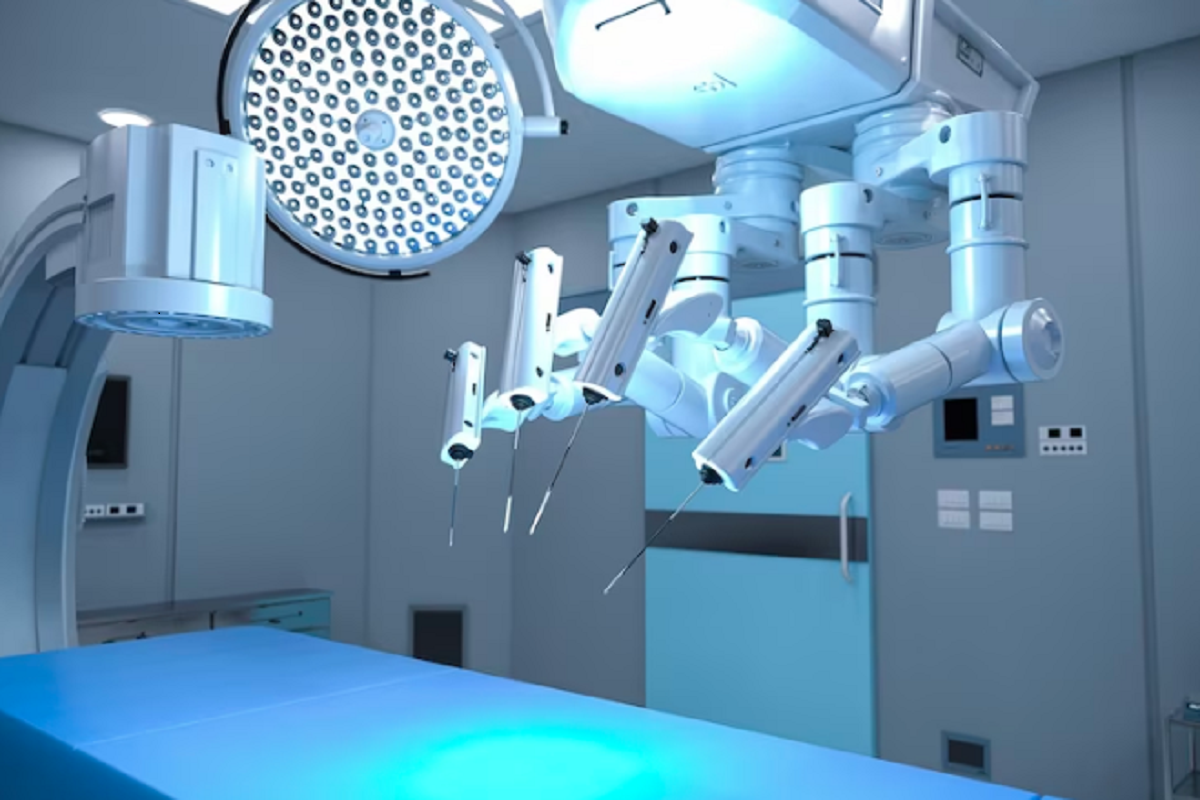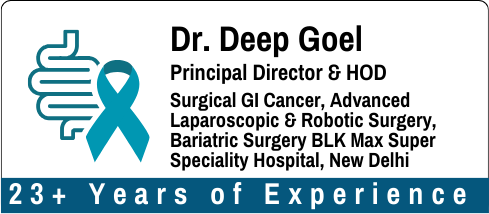How Robotic Surgery is Transforming Gastrointestinal Procedures?

For years, gastrointestinal (GI) surgery has been offering treatment for conditions ranging from acid reflux and gallstones to complex colorectal cancer. Traditionally, these procedures involved large incisions, long hospital stays, and extended recovery periods.
However, advancements in medical technology have introduced robotic surgeries- a cutting-edge innovation that is changing the way GI surgeries are performed. Robotic surgery enhances standard minimally invasive techniques by providing superior precision, greater flexibility, and improved visualisation.
Annually, over 60,000 robotic-assisted surgeries are performed in India across specialities, including general surgery, oncology, cardiology, gynaecology, and joint surgeries. The overall increase in robotic-assisted procedures suggests a growing adoption in GI surgeries as well.
A top gastrointestinal robotic surgeon in Delhi, Dr. Deep Goel, highlights, “Initially, open surgeries were the standard approach. The introduction of minimally invasive surgery provided some relief by reducing incision size and recovery periods. Laparoscopic procedures had limitations, which have been effectively addressed by robotic-assisted surgery.”
This blog explores how robotic-assisted surgery has revolutionised GI procedures and its advantages over traditional methods.
What are the Advantages of Minimally Invasive Robotic-Assisted GI Surgery?
As an advanced form of minimally invasive surgery, robotic-assisted surgery enhances accuracy, reduces complications, and improves patient outcomes.
High Visualisation with 3D Imaging
Robotic surgery offers a high-definition, three-dimensional (3D) magnified view of the surgical site, allowing surgeons to navigate intricate GI structures with precision.
Enhanced Range of Motion
Robotic-assisted surgery employs articulated instruments that can rotate 360 degrees, replicating the natural movements of a human wrist but with enhanced flexibility and precision.
Increased Precision
Even the most skilled surgeons are prone to minor hand tremours, which are eliminated by robotic surgical systems through motion scaling technology, allowing more stable and controlled movements.
Smaller Incisions
One of the most notable advantages of minimally invasive robotic-assisted GI surgery is the use of small incisions, resulting in less tissue trauma, reduced blood loss, and lower infection risks.
Improved Surgical Accuracy
The extreme precision required for suturing and anastomosis (the process of connecting sections of the gastrointestinal tract) is provided by robotic surgery through accurate needle placement.
Which Robotic Surgeries Are Performed in GI Procedures?
Robotic-assisted surgery has been successfully integrated into various gastrointestinal procedures.
- Colorectal surgery: Robot-aided colectomy improves precision in the removal of diseased sections of the colon, reducing complications in colorectal cancer and inflammatory bowel disease surgeries.
- Gastric surgery: Procedures like gastric bypass and sleeve gastrectomy for weight loss benefit from robotic precision in tissue removal and anastomosis.
- Oesophageal surgery: Robotic surgery enhances the accuracy of oesophagectomy procedures for oesophageal cancer, improving survival rates.
- Hernia repair: Robotic hernia repairs offer superior mesh placement and suturing, minimising recurrence risks.
- Gallbladder and liver surgery: Robotic systems improve the safety of cholecystectomy and liver resections by reducing the risk of bile duct injuries and ensuring precise tumour removal.
A patient of Dr. Deep Goel shares his experience, “I was initially anxious about undergoing robotic-assisted surgery for my hernia repair, but the experience was far better than I expected. The pain was minimal, and I was able to return to work within 2 weeks.”
How Does a Patient Benefit from Robotic Precision in GI Surgeries?
Patients undergoing robotic-assisted gastrointestinal surgery experience many benefits, including:
- Reduced blood loss
- Lower risk of infection
- Less pain and discomfort
- Minimal scarring (better cosmetic outcomes)
- Lower complication rates (leaks, strictures, and infections)
- Shorter hospital stay
- Faster recovery
Dr. Deep Goel shares his views on the changing treatment landscape, “The 3D magnified view and higher instrument precision allow us to perform complex surgeries with minimal risk to surrounding tissues. This leads to positive outcomes, especially in delicate surgeries like colorectal and oesophageal procedures.”
What are the Steps to Prepare for Robotic Surgery for GI Treatment?
Careful preparation is essential for a successful robotic-assisted gastrointestinal procedure.
- Medical evaluation: A pre-surgical assessment, including blood tests, imaging scans, and medical history review to ensure patient suitability.
- Medications and dietary adjustments: Patients may need to stop certain medications and follow a specific diet to prepare their digestive system.
- Pre-operative fasting: Patients are required to fast for several hours before surgery to minimise anaesthesia-related complications.
- Discussing expectations: Understanding the procedure, potential risks, and recovery process with the surgeon to set realistic expectations and reduce anxiety.
- Post-surgical planning: Arranging for post-surgical care, including assistance at home and follow-up appointments for smooth recovery.
What Happens During Robotic Surgery for GI Procedures?
Robotic surgery for GI procedures follows a structured approach:
- Anaesthesia administration
- Small incisions and port placement (robotic instruments, along with a high-definition camera, are inserted through these ports)
- Surgeon-controlled robotic system
- Surgical procedure execution (robotic system assists in cutting, suturing, and removing diseased tissue)
- Incision closure and recovery
Rajesh Kumar Gupta, spouse of a patient of Dr. Deep, expressed his thankfulness, saying, “My wife named Sneha underwent a hernia surgery. I really thank Dr. Goel and his team. They all were very supportive and active the entire period of my wife’s stay at the hospital. Dr. Deep has a very good approach towards his patients. I highly recommend him to those who are all having stomach-related problems.”
What is the Recovery Time After Robotic Gastrointestinal Surgery?
While recovery can vary depending on the specific procedure and the patient’s overall health, one of the key benefits of robotic surgery is its ability to reduce recovery time compared to traditional open surgery.
On average, patients can expect to resume light activities within a few days and return to full function within 2 to 4 weeks. In contrast, traditional open surgery often requires 6-8 weeks for full recovery.
What is the Cost of Robot-Assisted Gastrointestinal Surgery?
The cost of robot-assisted gastrointestinal surgery depends on hospital location, surgeon expertise, technology and equipment fees, and the complexity of the procedure. On average, it lies between INR 2,00,000 and INR 5,00,000 (USD 2400 and USD 5800 for international patients).
Conclusion
Robotic-assisted surgery has improved accuracy in gastrointestinal procedures, offering superior precision, reduced complications, and better patient outcomes. As technology continues to advance, robotic surgery will further transform the field, ensuring safer and more effective treatment for patients worldwide.
FAQs
1. What are the risks associated with robot-assisted GI surgery?
Potential complications of the surgery include infection, bleeding, or organ injury, similar to other surgical procedures.
2. Is robotic gastrointestinal surgery painful?
Patients generally experience less pain compared to open surgery, as smaller incisions lead to reduced tissue trauma and faster healing.
3. Can all GI conditions be treated with robotic surgery?
While many GI procedures can be performed robotically, some complex cases may still require traditional surgical approaches.
4. What is the success rate of robot-assisted GI surgery?
The success rate is between 90-95%, with studies showing improved precision, fewer complications, and better recovery outcomes compared to traditional surgery.
5. How long is the hospital stay after robotic GI surgery?
Most patients stay in the hospital for 1 to 3 days, depending on the complexity of the procedure and individual recovery progress.
Explore more blogs: Robotic vs. Traditional Surgery: Choosing the Best Option for Gastrointestinal Cancer Treatment

